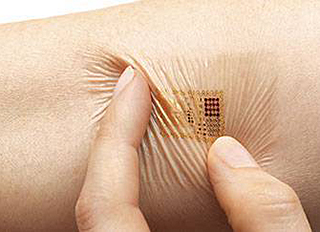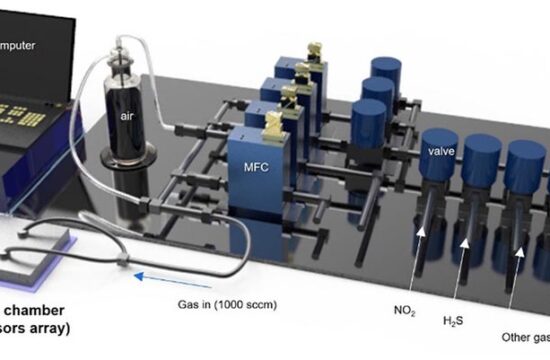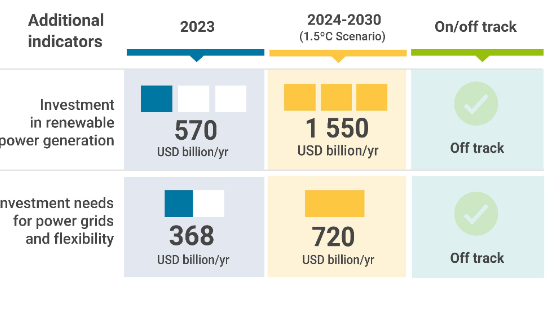
MC10, a startup in Cambridge, MA, is developing a technology that will allow digital circuits to be embedded in bendable, stretchable materials, which allows exploration of entirely new form factors for electronics — including a form of “electronic skin.” MC10 has overcome the rigidity of normal electronic components by printing them in very small pieces and arranging them in wavy patterns.
The company states on its Web site: “We take conventional high-performance electronics and turn them into body-integrated form factors that stretch, bend and twist seamlessly with our bodies and the natural world… Our devices incorporate silicon devices thinned to a fraction of the width of a human hair. These chips, combined with stretchable metallic interconnects, are further combined with elastic rubberlike polymers to form complete powered systems that sense, measure, analyze and communicate information.”
BioStamp, a flexible computing prototype developed by John Rogers, a materials scientist at the University of Illinois at Urbana Champaign, can be worn constantly. The technical founder of MC10 and father of MC10’s conformal electronics technology, Rogers is passionate about doing cutting-edge research and seeing it applied in real products that have an impact on the world.
As the Lee J. Flory-Founder Chair Professor of Engineering at the University of Illinois, Urbana- Champaign, with a primary appointment in Materials Science and Engineering, Rogers leads one of the largest and “most productive research groups on the planet,” with more than 45 Ph.D. and post-doc students working on different aspects of electronic materials. Prior to UIUC, he served as Director of Condensed Matter Physics Research at Bell Laboratories.
Flexible electronic circuits, aka “epidermal electronics,” containing a collection of sensors can be applied directly to the skin like a thin Band-Aid or a temporary tattoo. The latest MC10 prototype is applied directly to the skin using a rubber stamp and can be covered with spray-on bandage to make it more durable and waterproof enough to withstand sweating or washing with soapy water.
The thin electronic mesh stretches with the skin and can monitor data from the brain, muscles, heart, temperature, movement, hydration and strain. It lasts up to two weeks before the skin’s natural exfoliation causes it to come away.
“Our prototypes can provide a variety of monitoring and stimulation functions,” Rogers said in a conversation with CNN’s Kieron Monks. For example, “we can pick up coordinated firing of neurons, and run that activity through a computer spelling interface, so that brainwaves pick letters out of a virtual keyboard display and type messages.
“The history of electronics is about getting closer to the individual. At first, it was a computer down the hall, followed by a desktop, then a laptop, a phone in your pocket and a watch on your wrist. Now, it could be electronics integrated the skin, bioelectronics and fully implantable devices. To go fully into the realm of integrated electronics makes sense to me.”
BioStamp could be developed for use in healthcare to monitor patients. Monitoring in a natural environment during normal activity is especially beneficial for continuous monitoring of health and wellness, cognitive state, or behavioral patterns during sleep. Not only would this be more convenient than tethering patients to large machines, but the results could be more accurate if obtained in patients’ normal environments doing usual activities. Another major advantage of skin-like circuits is that they don’t require conductive gel, tape, skin-penetrating pins or bulky wires, which can be uncomfortable for the patient and limit coupling efficiency. They are much more comfortable and less cumbersome than traditional electrodes and give the wearers complete freedom of movement.
The skin-mounted electronics could have many biomedical applications, including EEG and EMG sensors to monitor nerve and muscle activity. They could potentially help to reduce trips to the doctor and the rate of ER visits. Other applications could include a patch that alerts an athlete to when and how much to hydrate to achieve peak performance, or one that prompts you when it’s time to apply more sunscreen.
The patch uses a thin film battery technology that complements the thin electronics in the wearable patch. It is a rechargeable cell capable of powering the patch for many hours. Wireless is used to both interrogate and power the patch. MC10 also has said that it is working on the integration of wireless power sources and communication systems to relay the information gathered to a smartphone.
MC10’s strategic development partners include Reebok, Medtronic, Massachusetts General Hospital, Diagnostics For All, as well as several undisclosed partners.








